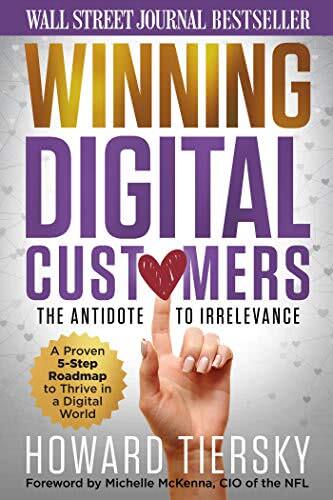
How Do Customers Love Thee? Let Howard Tiersky Count the Ways
By Jim Nowakowski, President, Interline Creative Group, Inc. (special to KB-Resource.com)
If you’re going to write about love, you should have read Ovid’s The Art of Love, Ars Amatoria. That book was written in 2AD as a series of poems trying to teach young men and women how to succeed in lovemaking.
Today, of course, no one reads Ovid. It’s the digital age, and who has the time!
That’s a mistake.
And it would be the same mistake you would make if you don’t read Howard Tiersky’s Winning Digital Customers: The Antidote to Irrelevance, which is essentially a book about love – gaining a customer’s love for your brand.
Tiersky clearly states his thesis early on page 12: “This book is a blueprint for earning love from today’s customers.” The book’s cover graphic actually has a heart as part of the word customers!
Tiersky’s book is not poetry, nor do I know if he read Ovid. What Tiersky’s book is, however, is a blueprint – a blueprint that examines “love” in this digital age as love relates to a business and love’s relationship with customers of a business. It’s more science than art, but that’s the nature of the digital age we live in.
In an odd sense, Winning Digital Customers is “digital poetry” because like Ovid’s Art of Love, Tiersky’s book is written to try to teach us how to succeed in getting our customers to love us. It is comprehensive, compelling and thoughtful. If you spend time with it – and time is the investment all lovers must make — you will be rewarded by many discoveries in what looks like science, but is really also art.
What’s Different About Tiersky
In 2015, Kevin Roberts, the Executive Chairman of Saatchi & Saatchi, one of the top agencies in the world, produced a “red” paper view of brand loyalty as it applied to the marketing imperatives of 2015 — imperatives that have evolved into what Tiersky is trying to tackle in his book: the love of customers. Saatchi & Saatchi called it a “red” paper (not the usual “white paper”) because they “operate from the edges, zig when others zag. Red is the color of passion, hope and optimism. Red is the color of spirit, the root word of inspiration.” This is Agency positioning, of course, and differentiation, which we all need, but it didn’t change the fact that its content was “leading edge.”
Roberts’ credentials are unmatched. The red paper is called “Brand Loyalty Reloaded” and it is highly recommended reading in addition to Tiersky, because in 2009 (when Roberts created the term “Lovemarks®,” the world was just becoming digital.
The essential thought behind Lovemarks wasdisarmingly simple:
Take a brand away and people will find a replacement.
Take a Lovemark away and people will protest.
In other words, Love is one powerful emotion. Emotions like love are very elusive when it comes to trying to quantify it with language. Which is what Roberts tried to do in one word: Lovemarks.
In particular, “Lovemarks proposes that mastering the emotional dimensions of marketing is by far the most important requisite of an enterprising life in business.” Oddly, it’s close to the basis of Tiersky’s thesis and book.
The example in the red paper Roberts gave was Google. “Lovemarks go beyond rational factors into the emotional territory of Mystery, Sensuality and Intimacy,” said Roberts.
And, that’s where Tiersky in his book will take you beyond what Roberts did: into the heart of the emotional territory of customer love in a digital age.
Love is a Many Splendored Thing
Love is intangible…strange…whenever emotions are discussed using language. But, Tiersky’s use of language is thorough (almost 400 pages), clear (stories abound as examples to prove his points) and probably much more than you’d expect in tackling this complex subject. The book, in short, is a treatise on the idea that obtaining customer love is the single most important factor in the success of any business.
And before you say, “so what else is new” – after all, if you read Lovemarks it’s basically talking about customer love and so is everyone else these days – think about this: in 2009 when Roberts wrote his book, digital – real digital, the kind we’re finding out about since COVID-19 — was just finding its sea legs. As Tiersky says, “To keep the love, you have to change with the times.” Anyone who has felt this emotion knows the truth of that simple statement. And Tiersky spends pages grappling with it, and proving it.
So, if we have to learn to cultivate love digitally – and who among us can deny that we do — Tiersky’s book turns out to be a comprehensive study on how to do just that. Because this is not a book for reading; it is a book for studying.
Houston, We Have a Problem
Tiersky’s opening line – “You Have a Problem” – throws down the challenge. He tells you if you are going to build a brand in today’s digital world, you have a problem. Tiersky states his premise of this problem in the first of six sections. Then he spends the other five (the rest of the book) taking you into the depths of “how to transform in order to win the love of your customers.” It’s like reading Crime and Punishment, where Raskolnikov commits the crime in the first 100 pages and spends the next 600 pages struggling with his inner self. And struggling for customer love is just that; only with Tiersky, we have a guide who helps us through love’s iterations.
It’s a tough, hard book to read because it tells you the truth about what you need to do to gain the love of your customers. The truth is never easy.
However, like many books written in this digital era, Tiersky has a website interface to support your entire journey. He explains where to go and the passcode you need to access the comprehensive materials online that can help your customer-love quest. This way of storytelling is the “digital” way of things. You will not be disappointed in these “extra” materials to support the study.
It’s Just Personal, Not Business
Tiersky also weaves in personal, human stories into his digital narrative that give a human touch to the intangibility of love in a digital world. Drawing on his business experiences as well, he tells us stories to underscore the points he is trying to make.
“Being digitally driven means far more than providing your customers with a good app” or “a company truly digitally driven becomes tough for traditional enterprises to compete with” seem sometimes obvious. But, they are backed up with solid stories and examples that pave the way for the other sections where the work to gain customer love takes place.
Tiersky calls them Activities. Each of the five activities takes the reader step by step through a process to understanding and gaining digital love. From “understanding your customer” to “mapping the customer journey” and finally” leading the change,” his book will guide a reader in an effort to quantify the emotion of digital love.
The Pain of Mapping the Customer Journey
For example, we’ve all heard “map the customer journey,” but Tiersky spends over 50 pages explaining just how complex that mapping should be. He talks about understanding two types of pain that are discovered in the mapping: blame pain and accepted pain. So, when you study this book – and that means reading it with a notepad by your side – you will examine such statements from your own point of view and do what Tiersky wants you to do: adapt what he is saying to your own experience when you begin your own mapping!
For example, my experience with pain is simple: no pain, no gain, remain the same. And change underscores everything in Tiersky’s messages to us — and the ongoing need to change. So, whether you use an adjective like “blame” or “accepted” in front of a word like pain is not the point: grappling with the pain you will experience is.
Pain is pain, and like love, feeling pain is a personal thing. But what if you can, for a moment, feel the pain like your customers might be feeling pain when they deal with you? What if the thought “how could I cause my customers pain” never entered your head? How would you hope to change?
When you realize pain from a customer’s point of view, you will change everything about your business. The Navy Seals have a theory about pain: pain lets you know you are still alive. Tiersky is suggesting, perhaps, we embrace a customer’s pain to learn from it. Then ultimately, defeat it by turning it into love.
Storytelling
This is not an easy task. But, his stories help – a lot.
In “What does being Digitally Transformed Look Like?” (Chapter Four), he tells the story of his 4-year old son asking about the remote control and pointing to the volume controls, asking if the buttons on one side make the sound get louder and quieter. Tiersky says, “Right,” in which case his son points to a similar set of up/down buttons on the other side of the remote asking the same question. Tiersky replies, “those change the channel.” The son asks, “What’s a channel?” Tiersky realizes explaining the concept of “channel” will not mean much anymore to his son.
 In Rorschach Test: Who Is Robert Redford?, I wrote about a young intern who took our Rorschach test. I have this picture hanging on my wall in my office and I ask people what they see. Generally, they describe something like “I see a wedding” or “I see two people laughing” and so on. I probe and inevitably they say, “That one looks like Robert Redford.” The young intern didn’t say that, so when I asked, “Does that one look like Robert Redford?” She replied like Tiersky’s young son: “Who is Robert Redford?”
In Rorschach Test: Who Is Robert Redford?, I wrote about a young intern who took our Rorschach test. I have this picture hanging on my wall in my office and I ask people what they see. Generally, they describe something like “I see a wedding” or “I see two people laughing” and so on. I probe and inevitably they say, “That one looks like Robert Redford.” The young intern didn’t say that, so when I asked, “Does that one look like Robert Redford?” She replied like Tiersky’s young son: “Who is Robert Redford?”
This type of disconnect—this “shared” experience that people with concepts of channels or Robert Redford — is what Tiersky drives into the reader through his exercises throughout the book – and the need to connect things again from the customer’s point of view if you’re going to gain their love.
It’s difficult. Very difficult.
I remember reading in Hemingway’s Farewell to Arms one of the most concise definitions of love I’ve ever come across, including any put forth by poets like Ovid. In that love story, Catherine tells Lt. Henry, “Love means there is no me. There is only you.”
And that is what Tiersky tries to convey in this book: there are no sellers. There are only buyers. Better get to know them if they are going to love you.
Catullus, a lesser known Roman poet but who lived around the time of Ovid, perhaps summed up what every seller should strive for from customers with a little more poetry: “Give me a thousand kisses, then another hundred, then another thousand, then a second hundred, then yet another thousand more, then another hundred. Then, when we have made many thousands, we will mix them all up so that we don’t know, and so that no one can be jealous of us when he finds out how many kisses we have shared.”
Let’s hope after the study of Tiersky, his knowledge will help us all achieve such brand intimacy.

Howard Tiersky is the author of the Wall Street Journal bestseller Winning Digital Customers: The Antidote to Irrelevance. He has been named by IDG as one of the “Top 10 Digital Transformation Influencers to Follow Today.” As an entrepreneur, he has launched two successful companies that help large brands transform to thrive in the digital age: FROM, The Digital Transformation Agency and Innovation Loft. His dozens of Fortune 1000 clients have included Verizon, NBC, Viacom, Avis, Universal Studios, JPMC, Crayola, Morgan Stanley, Condé Nast, the NBA, Visa, and digital leaders like Facebook, Spotify, and Amazon.
Editor's Note:
When KB-Resource published Howard Tiersky’s Four Little Fixes to Kick-Start Your Digital Transformation, the editor asked for a copy of the book and Dottie DeHart was kind enough to have Howard send it along. You never know if such requests get through, but this one did. We asked Jim Nowakowski to review it, who said, “It was a pleasure reading and producing this review to share with KB-Resource readers.” Whether you are immersed in digital or just learning how this world has shifted, you’ll find Tiersky’s book to be what Jim calls, “a pure study guide.” As always, we would appreciate any comments you may have about his review.